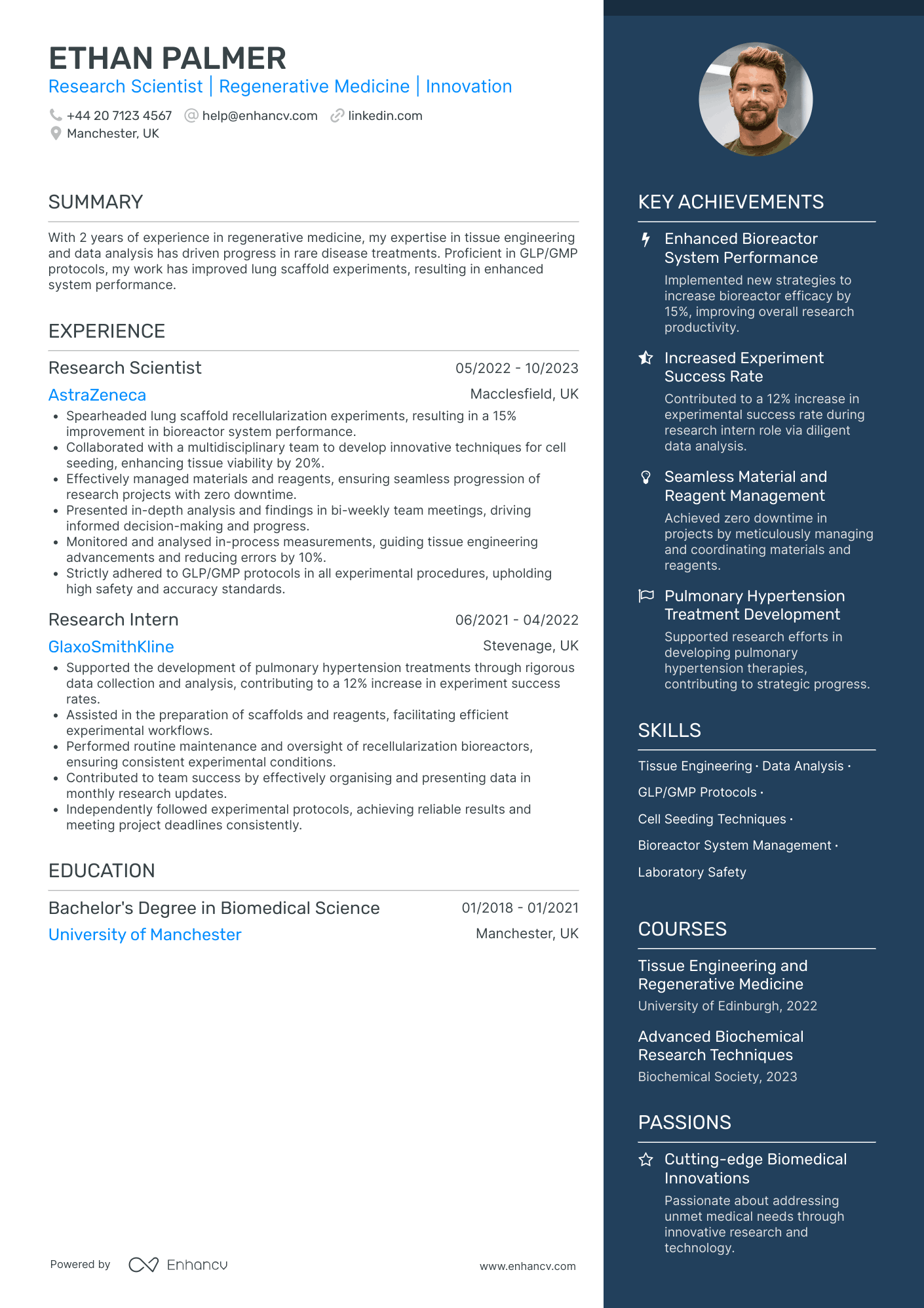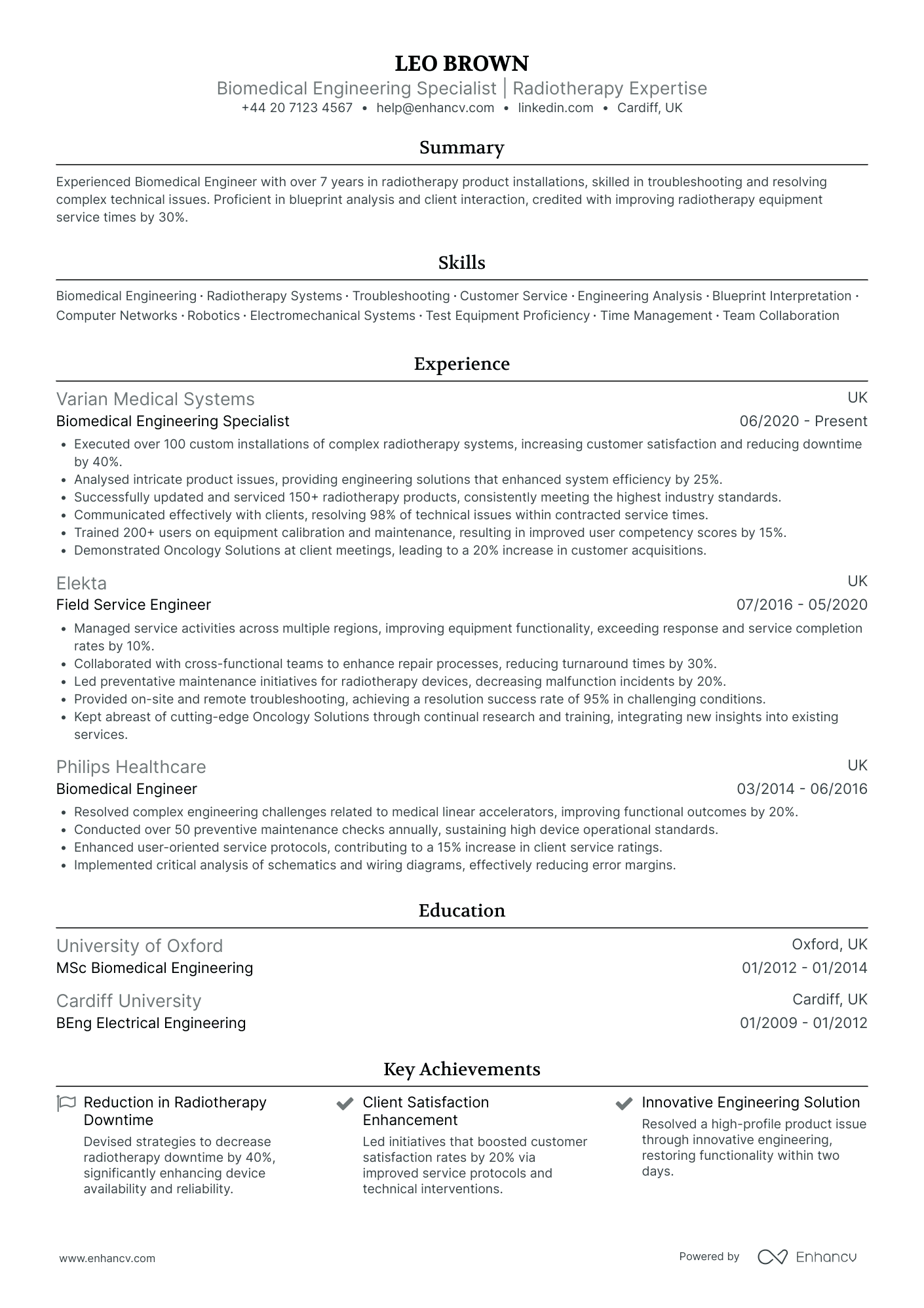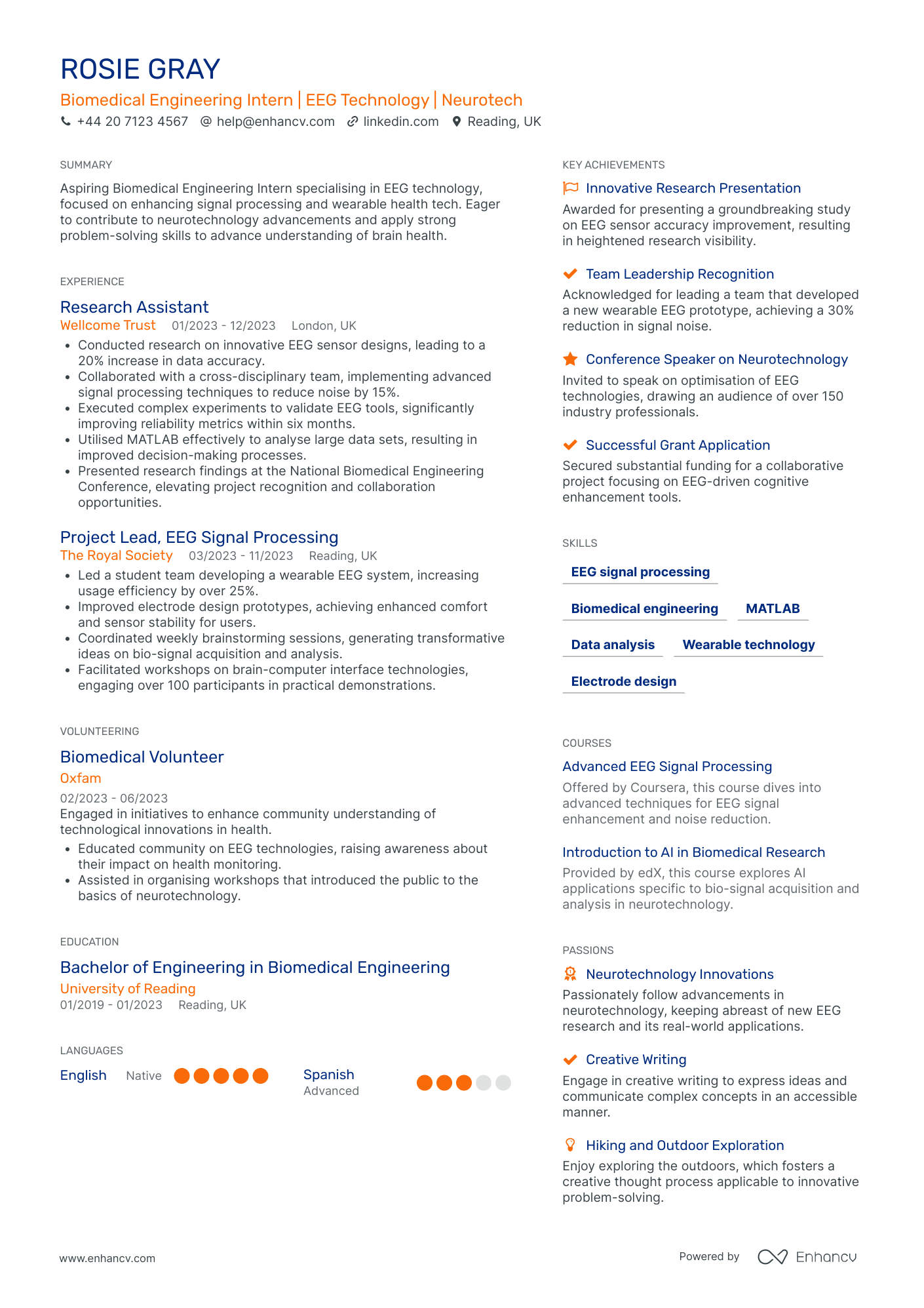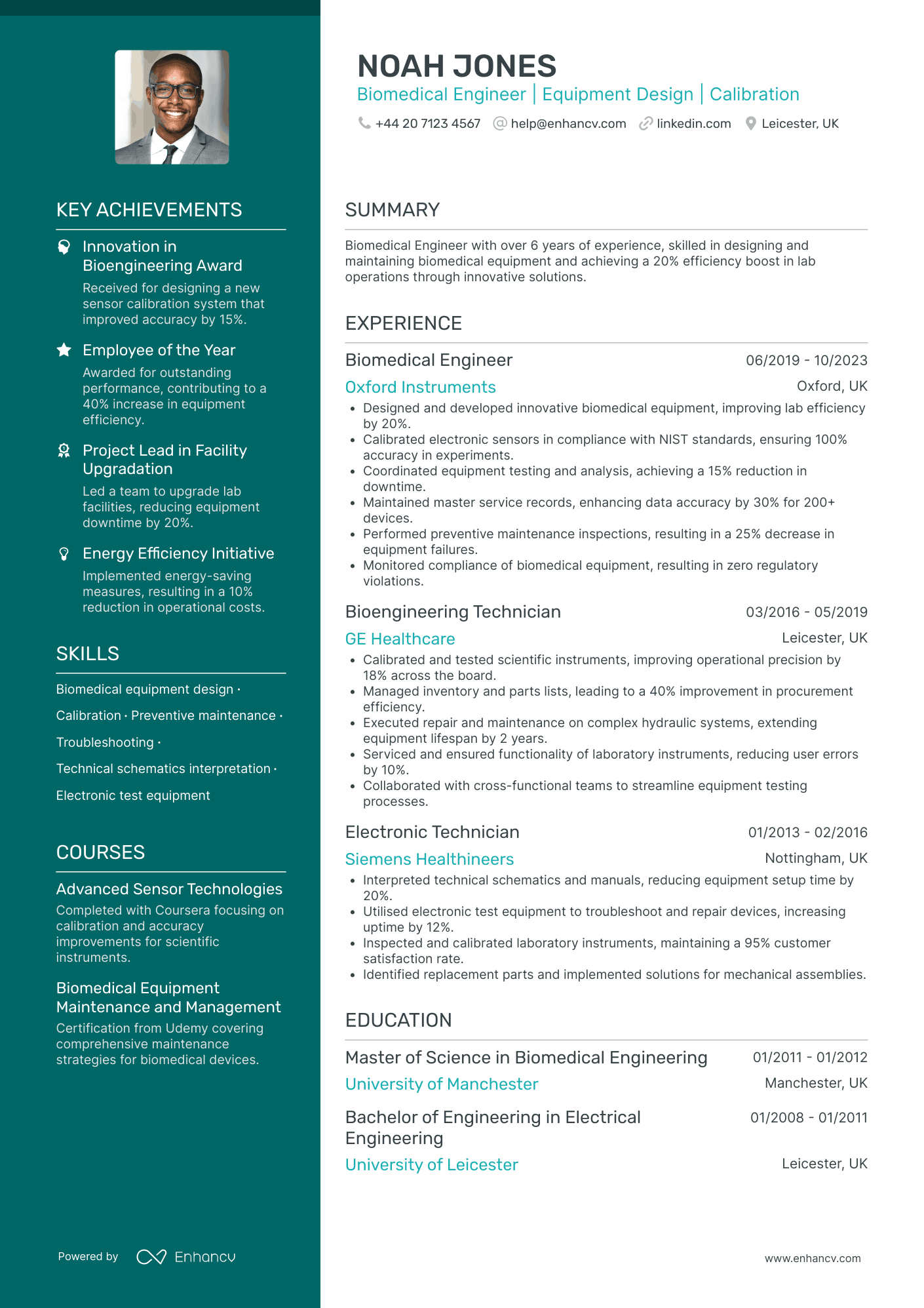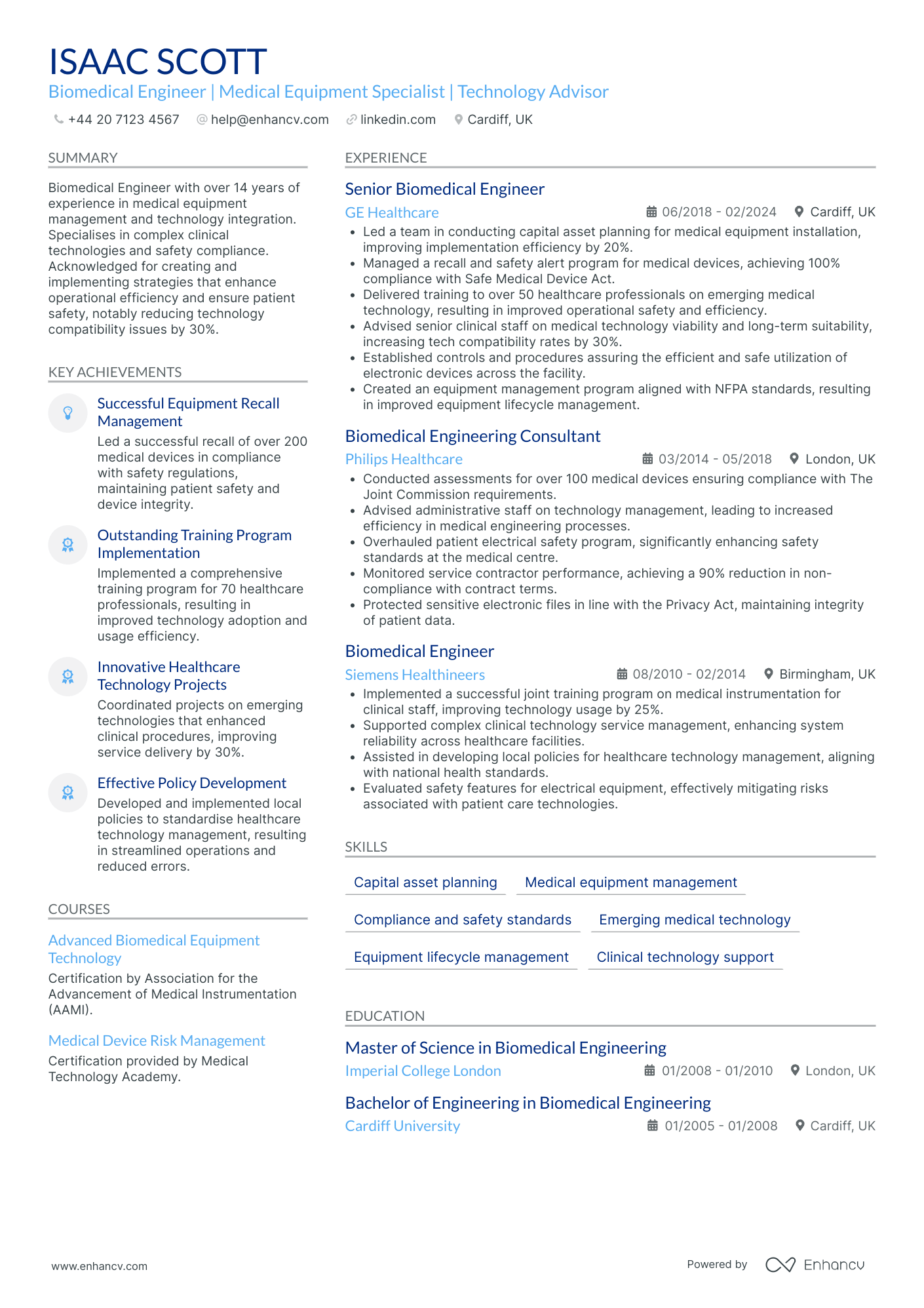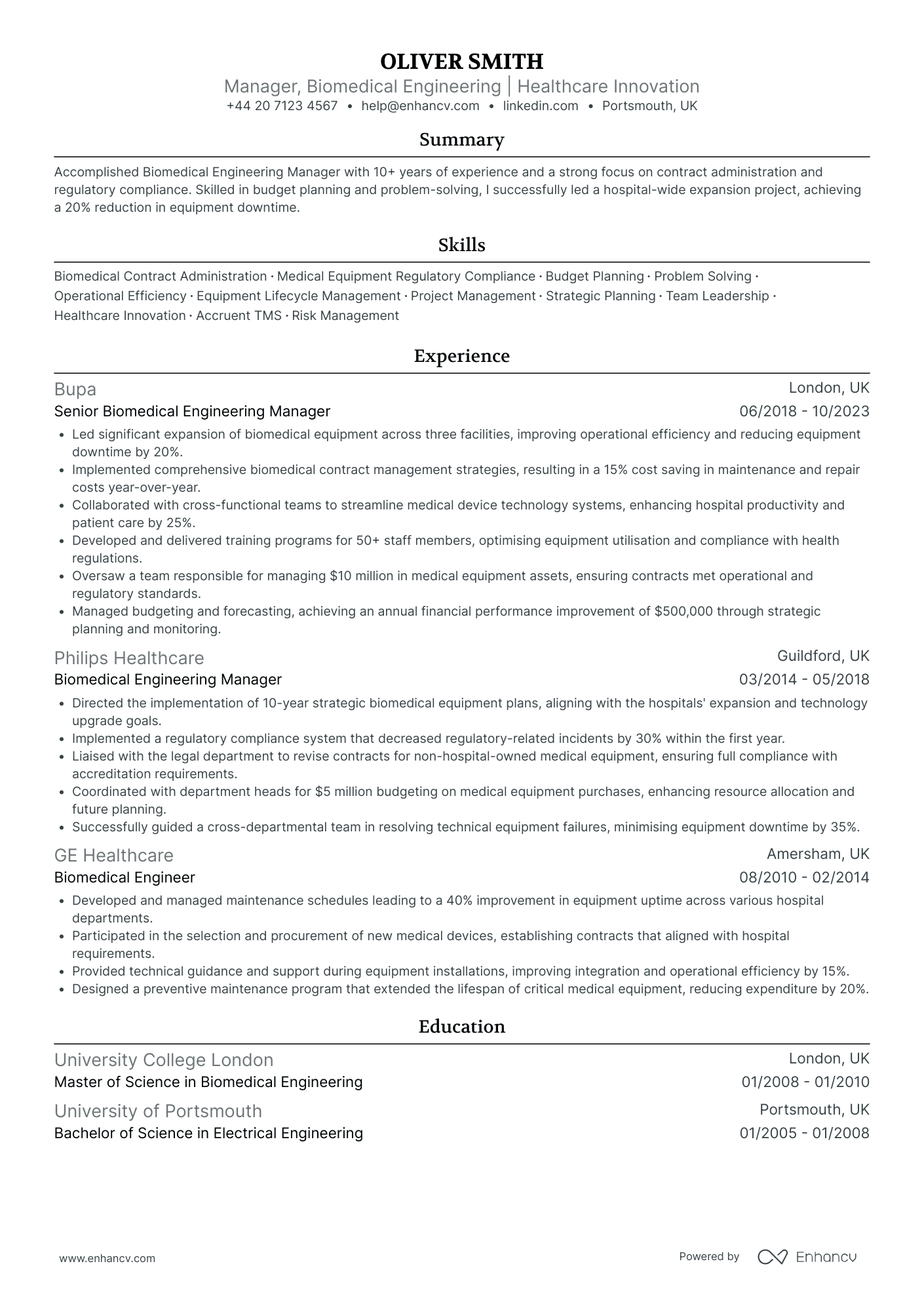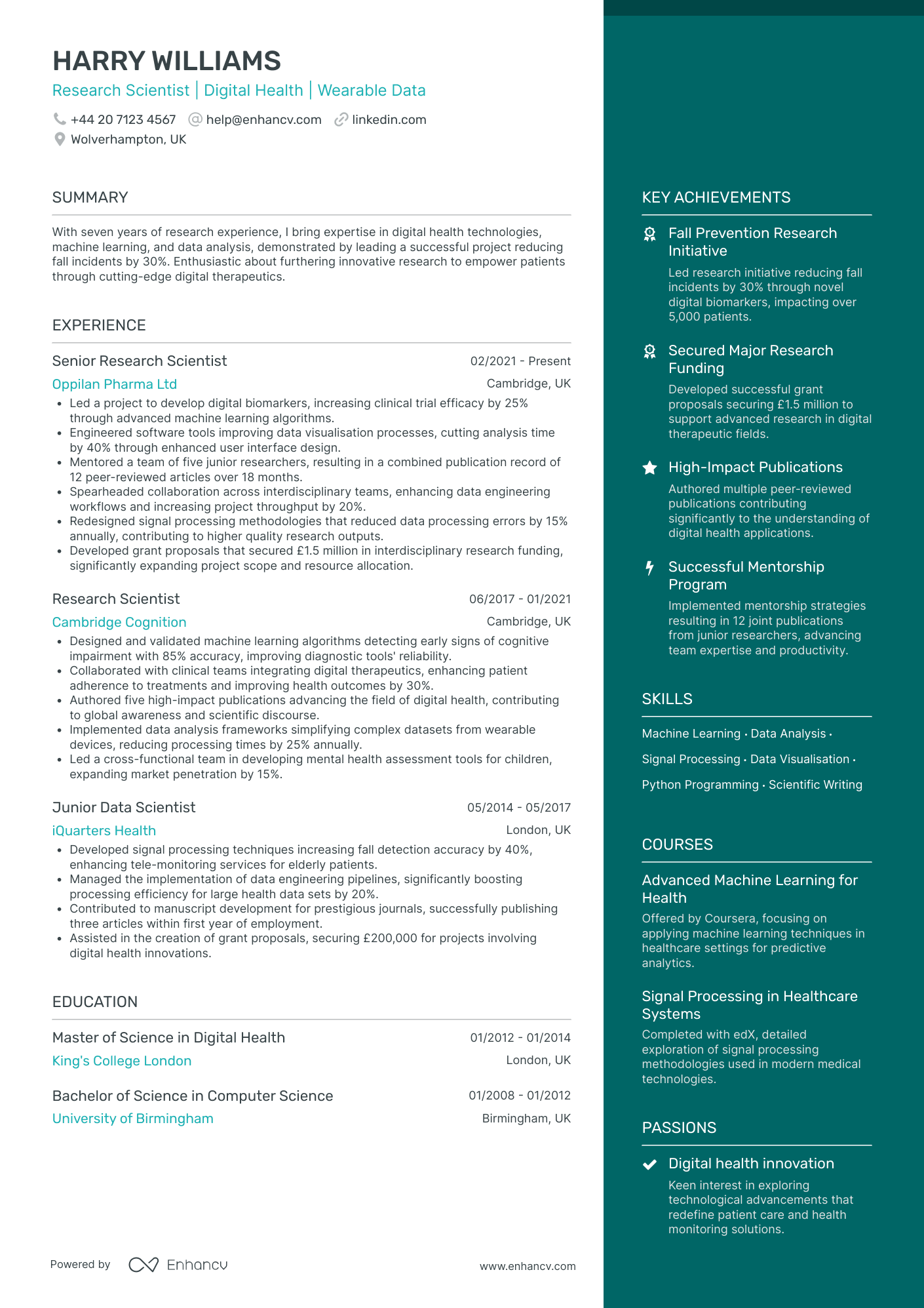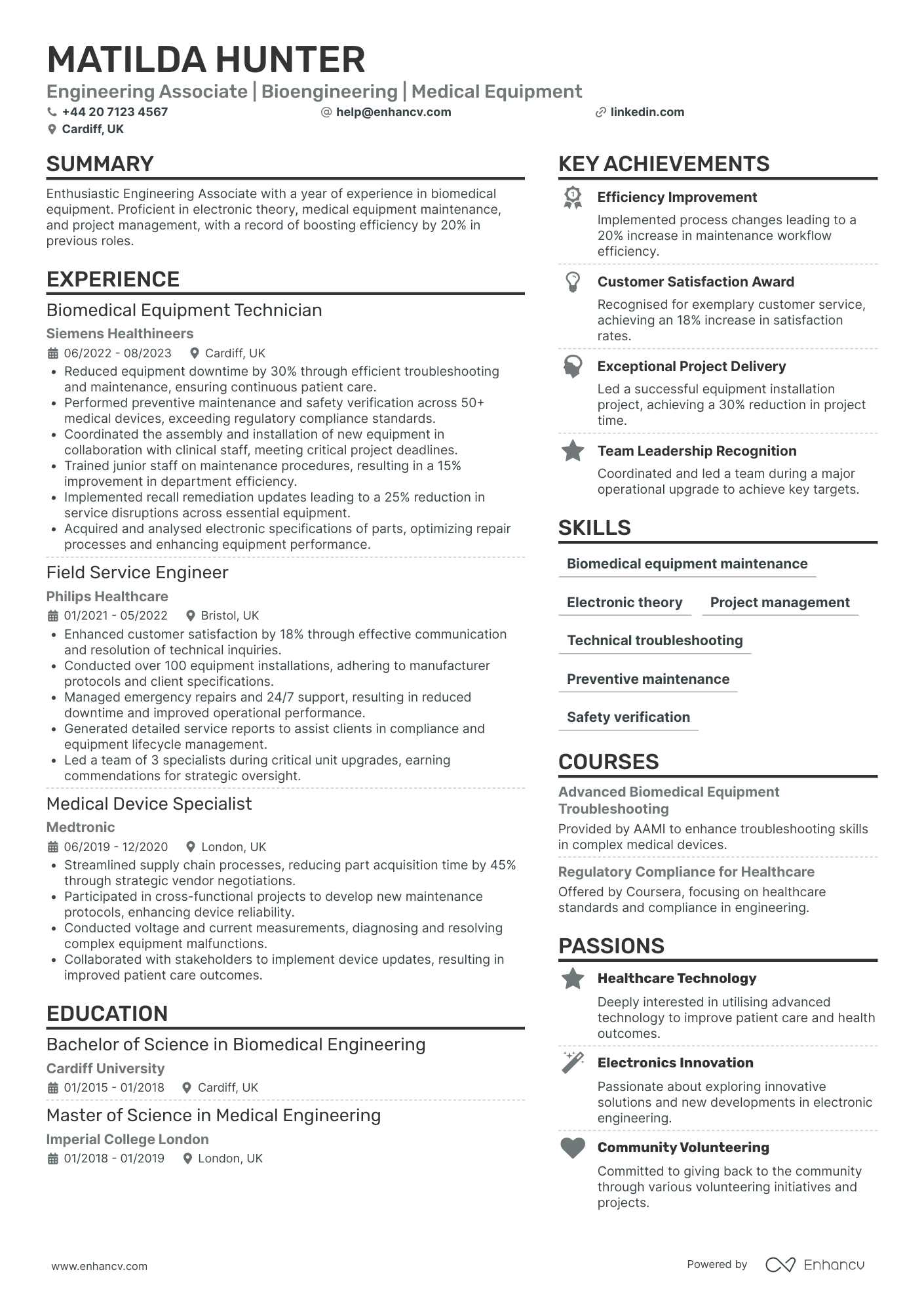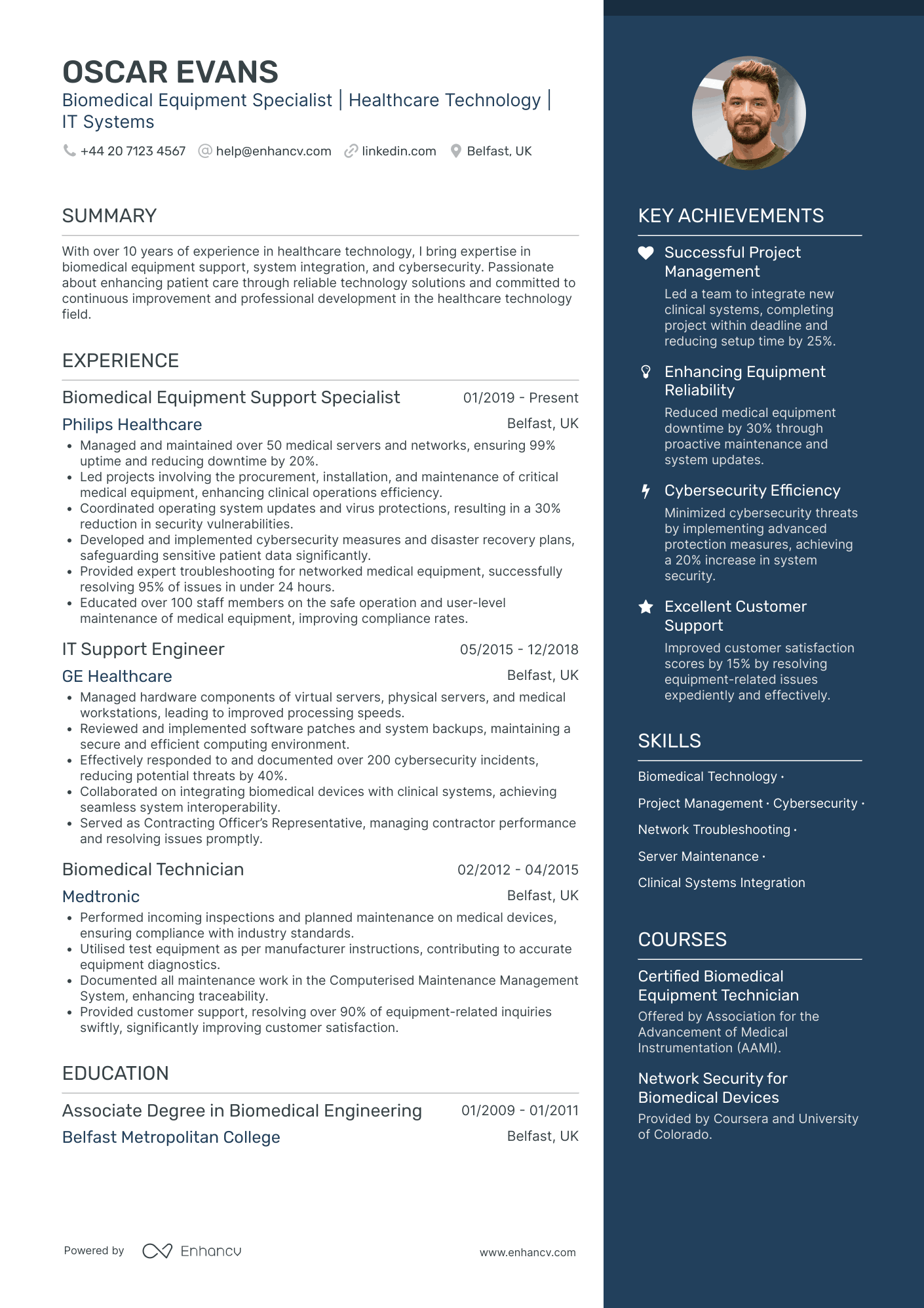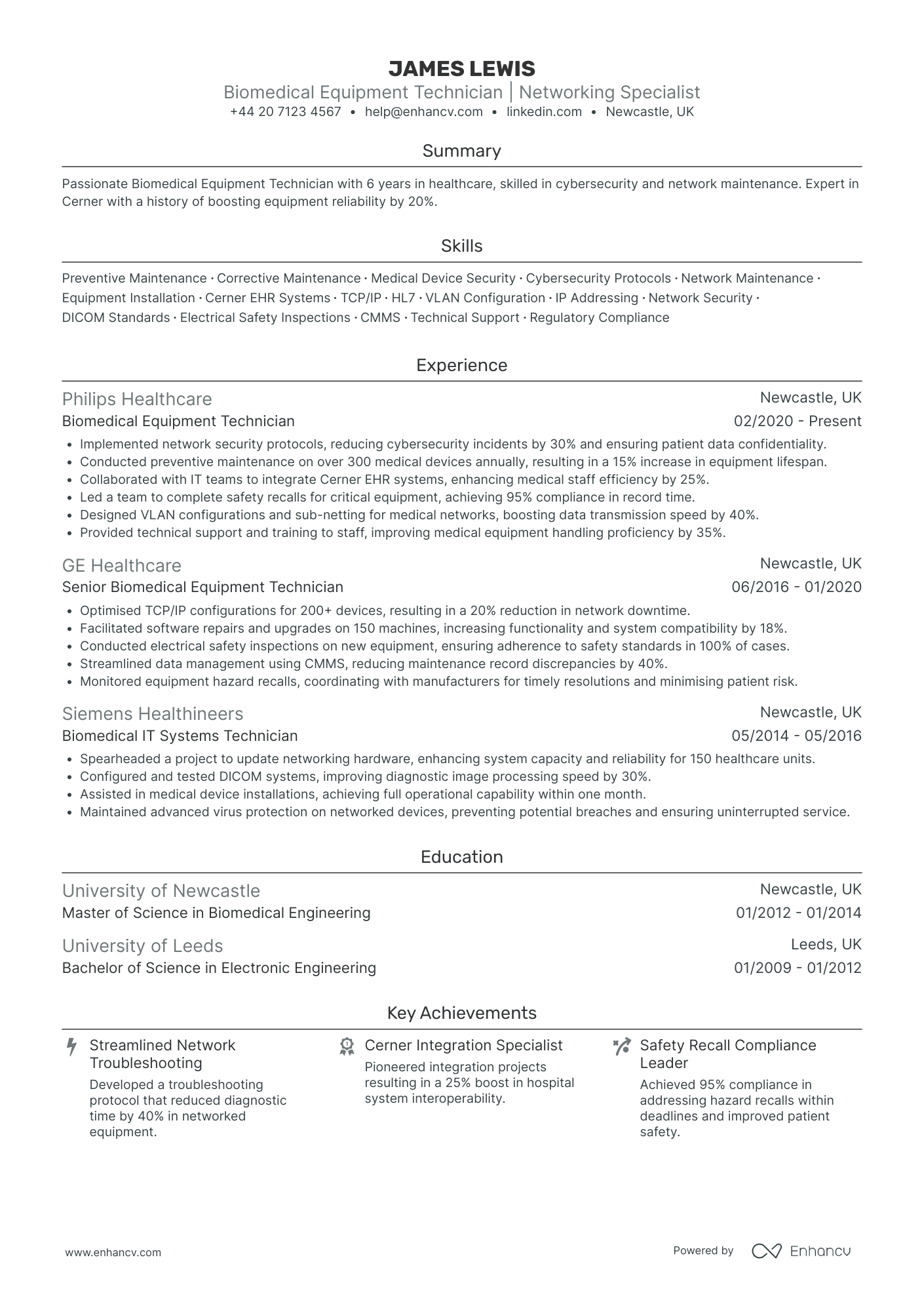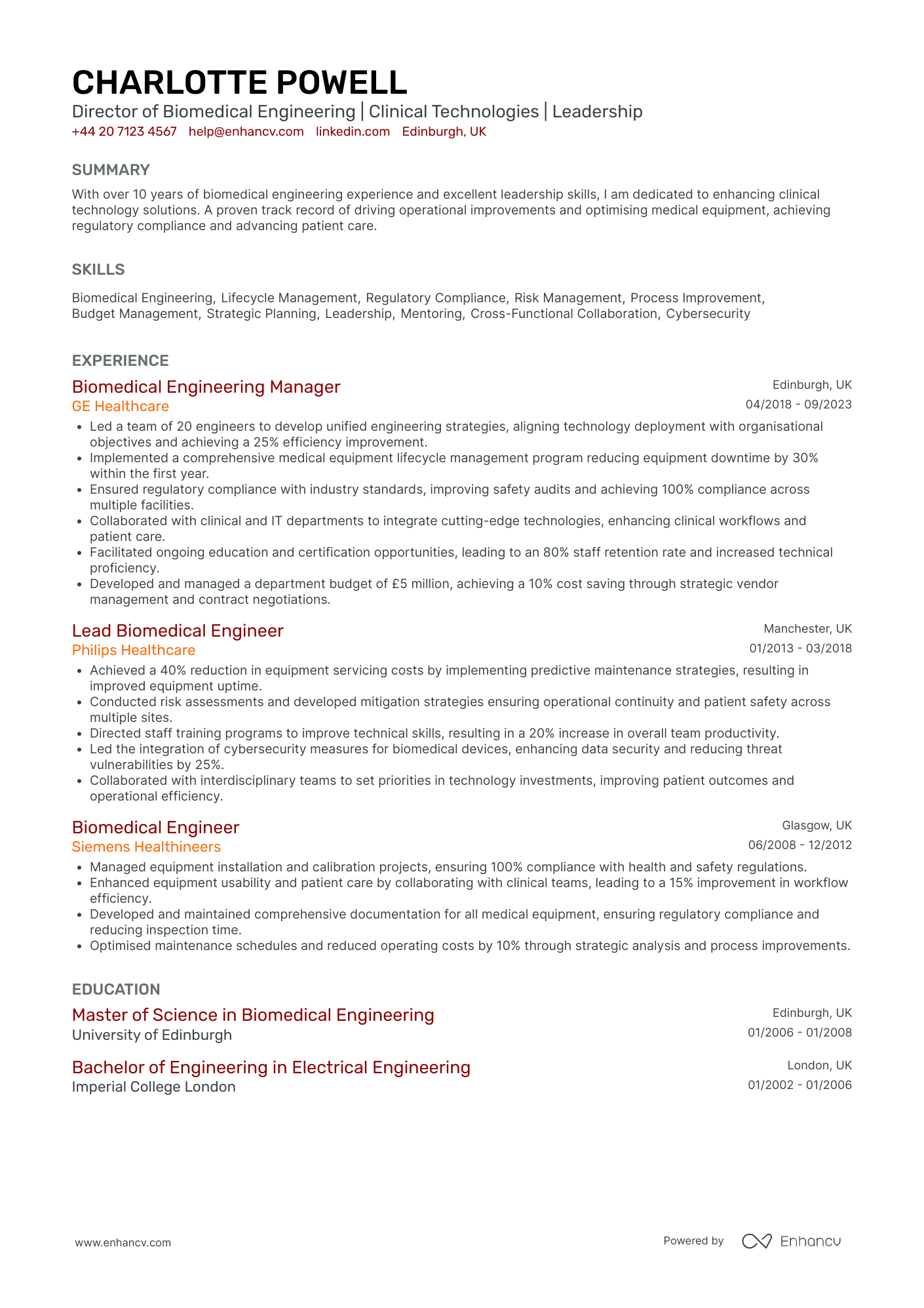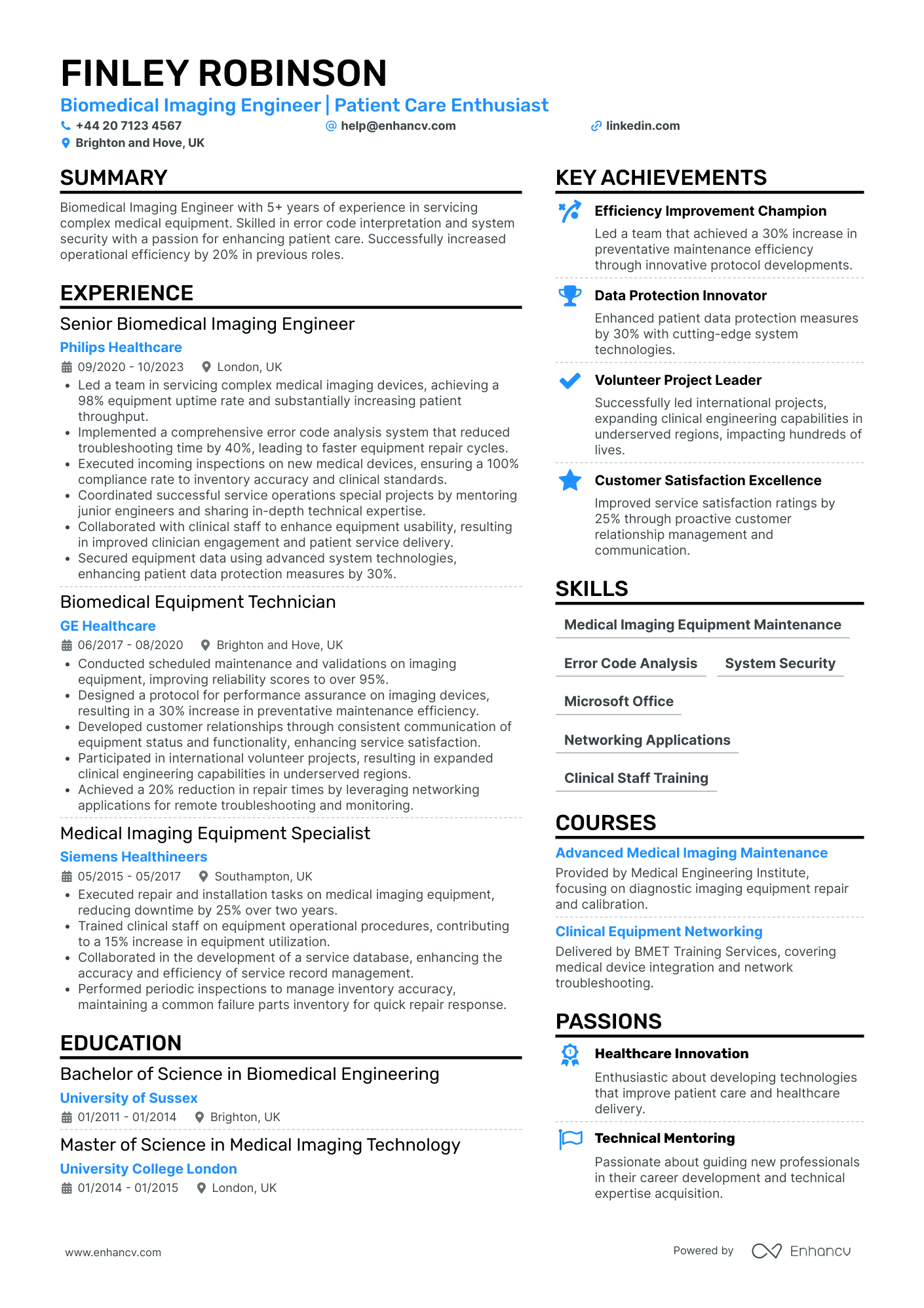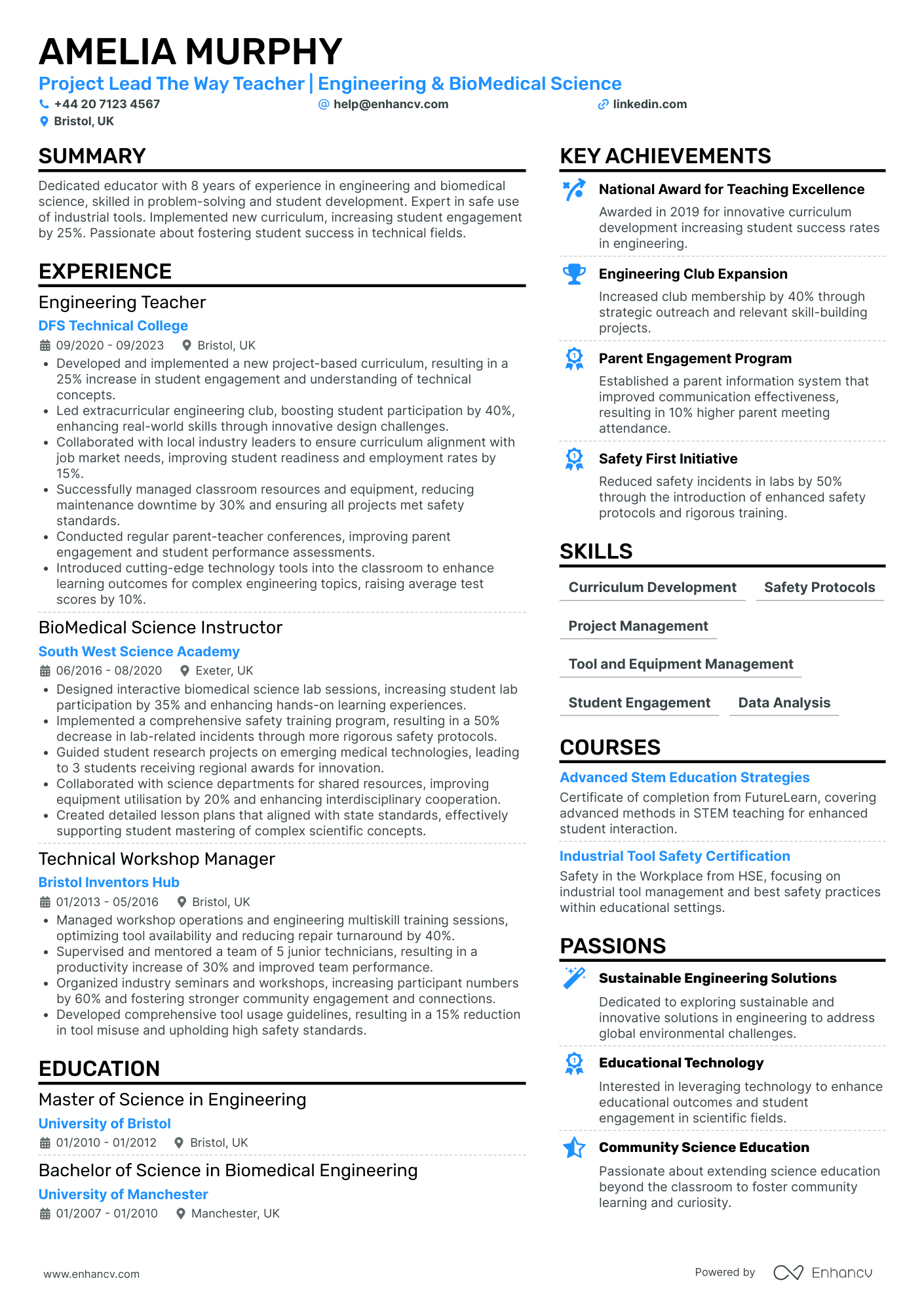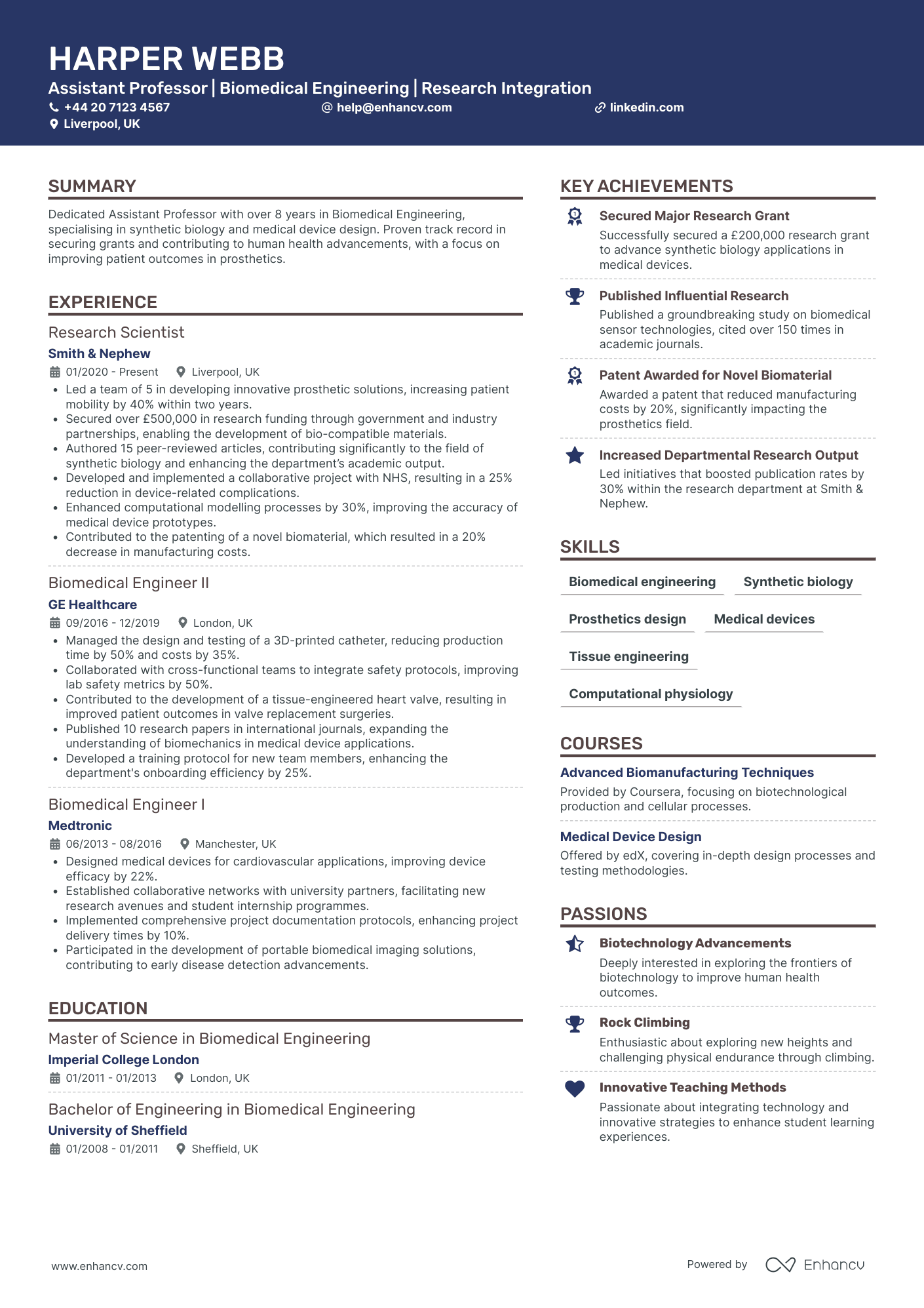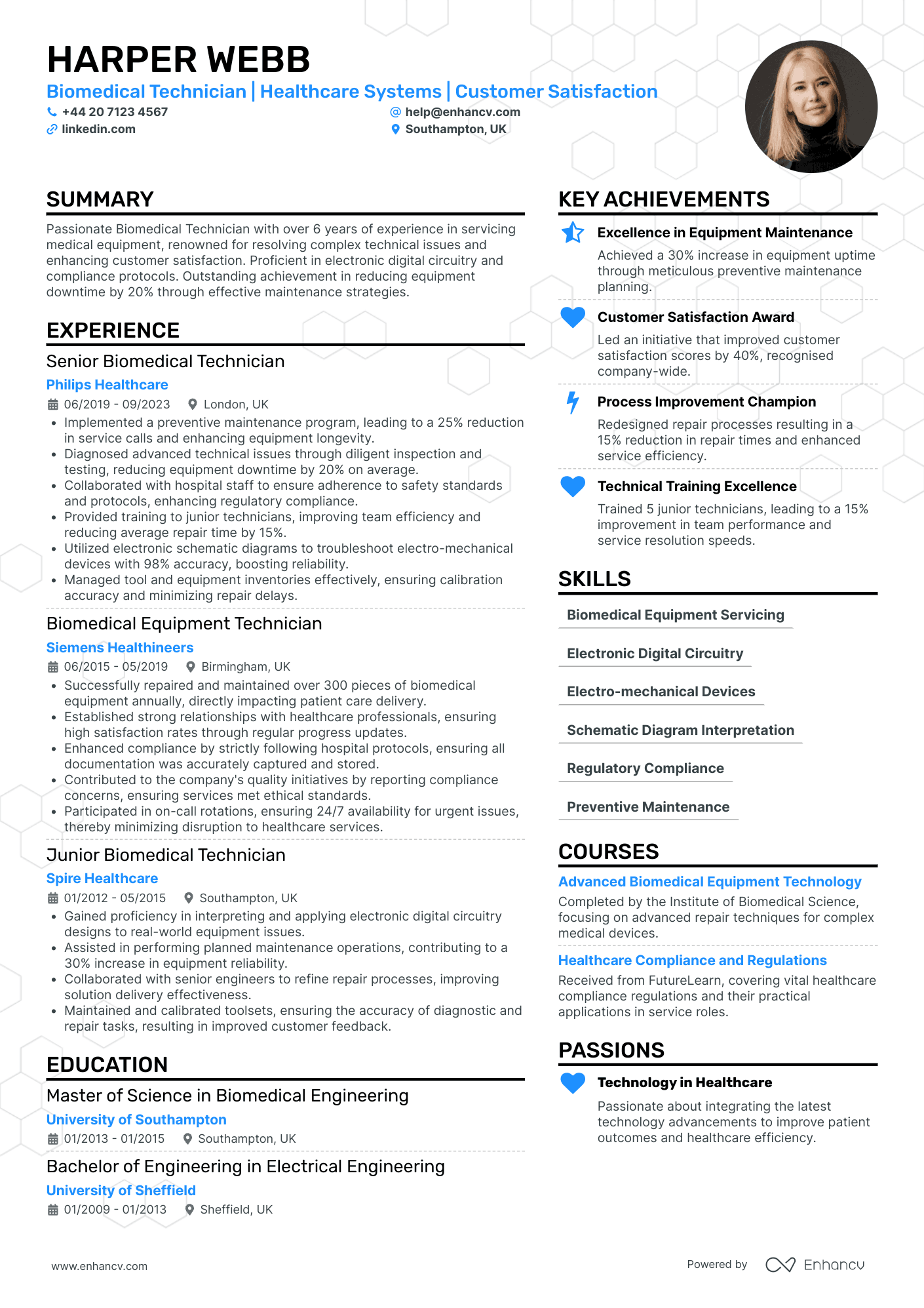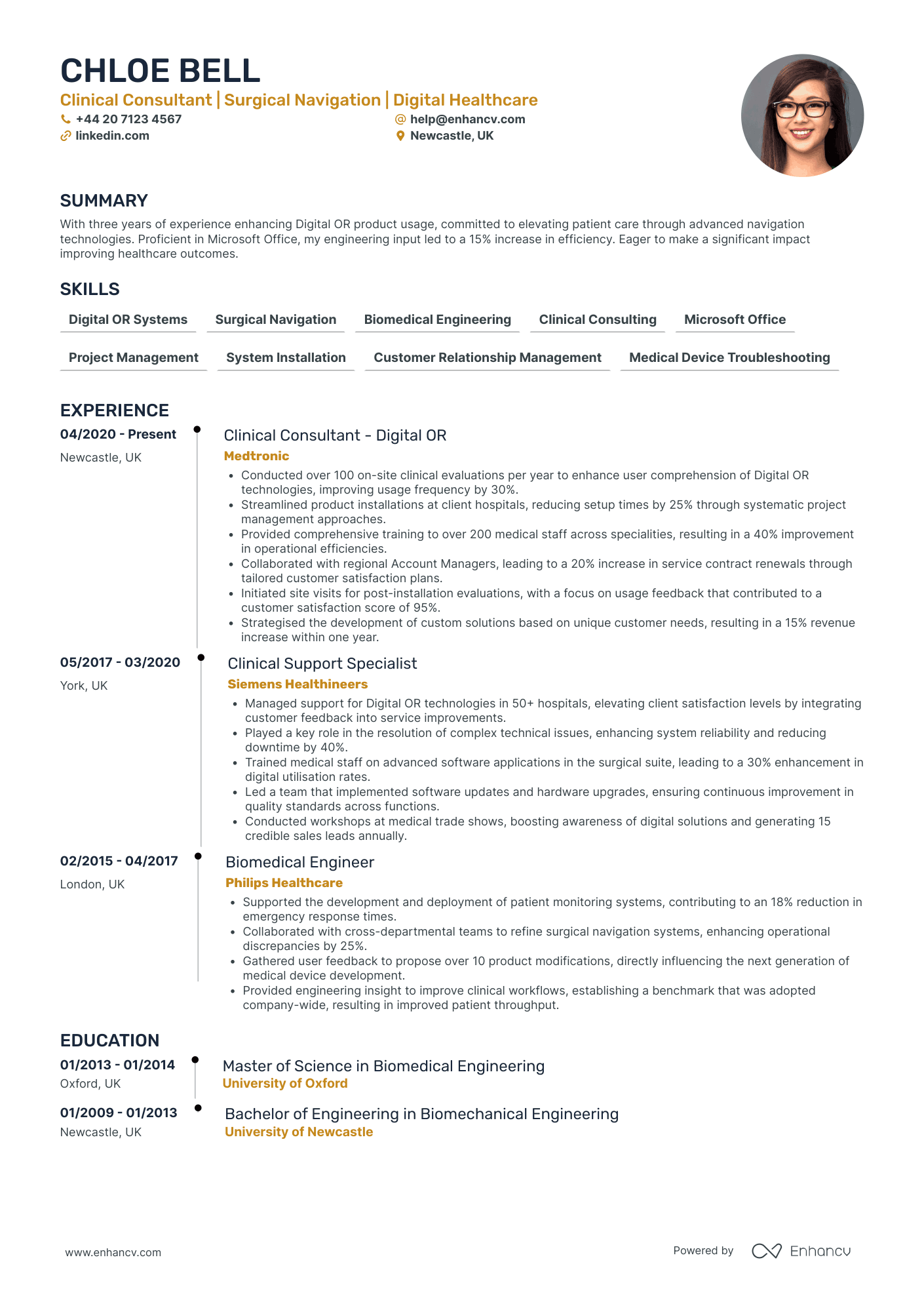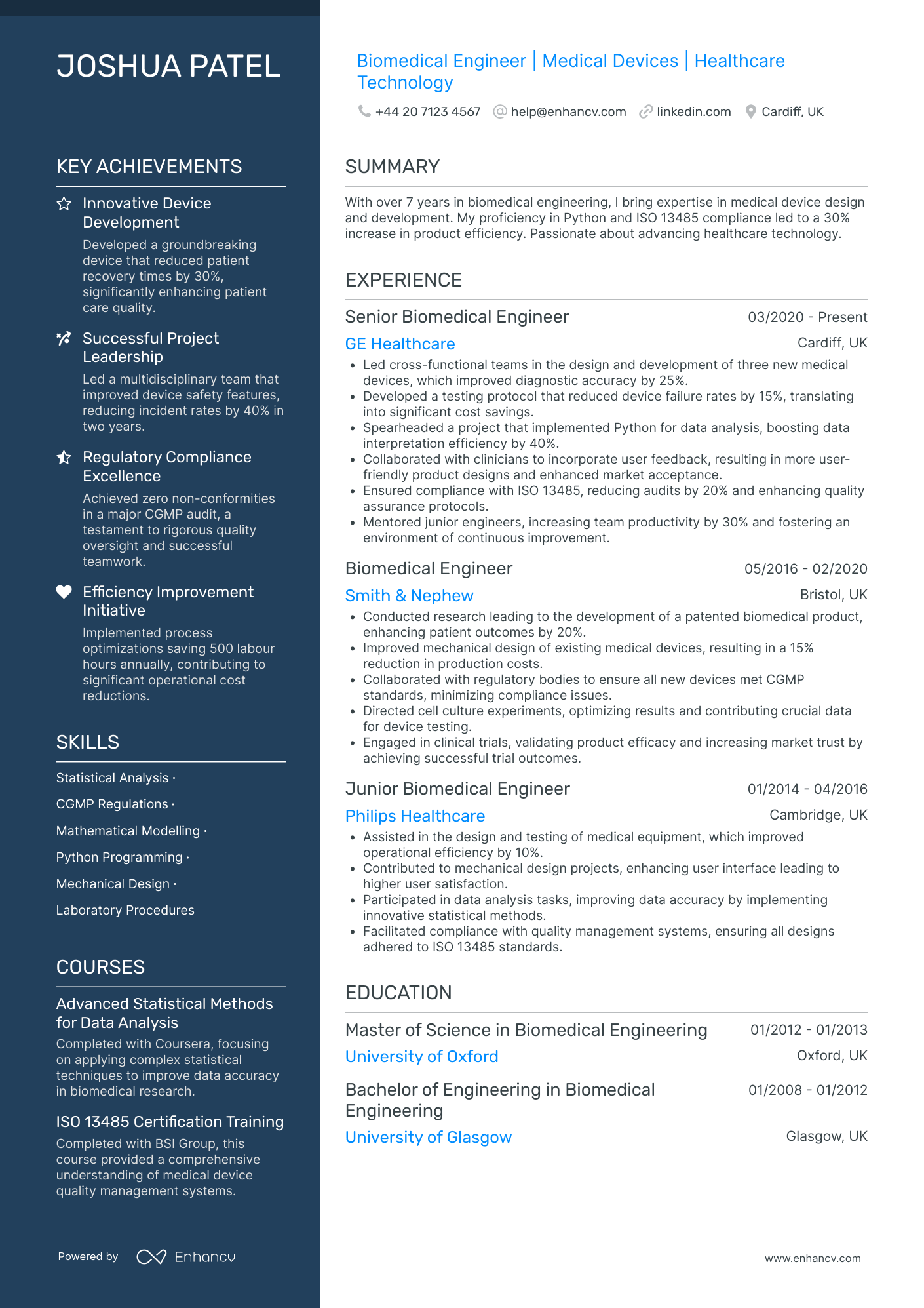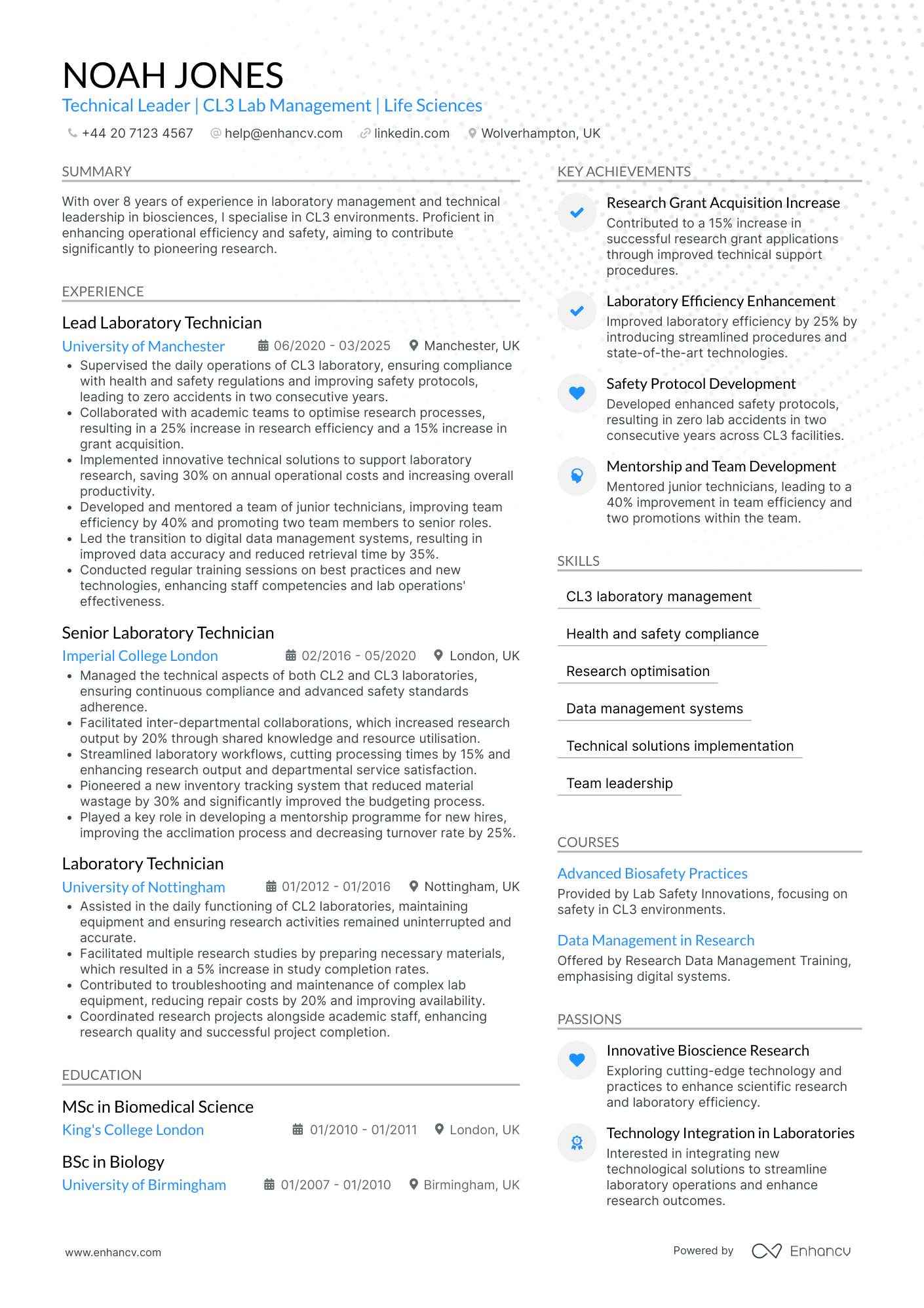Ensuring your CV stands out in the competitive field of biomedical engineering is a significant challenge, given the need to effectively showcase both technical expertise and innovative research experience. By following the strategies in our guide, you will learn how to emphasise your unique qualifications and successfully navigate through the nuances of crafting a compelling biomedical engineering CV.
- Design and format your professional biomedical engineer CV;
- Curate your key contact information, skills, and achievements throughout your CV sections;
- Ensure your profile stays competitive by studying other industry-leading biomedical engineer CVs;
- Create a great CV even if you happen to have less professional experience, or switching fields.
When writing your biomedical engineer CV, you may need plenty of insights from hiring managers. We have prepared industry-leading advice in the form of our relevant CV guides.
Resume examples for biomedical engineer
By Experience
Junior Biomedical Engineer
- Clear and Organized Structure - The CV is expertly structured with clearly defined sections including Summary, Experience, Education, Skills, Achievements, Courses, Passions, and Languages. This not only aids in readability but ensures that each aspect of Ethan Palmer’s qualifications is immediately accessible to recruiters, making it easy to gauge his fit for the role.
- Progressive Career Development - Ethan's career trajectory reflects a steady growth from a Research Intern at GlaxoSmithKline to a Research Scientist at AstraZeneca. This progression indicates his increasing responsibilities and recognition in the field of regenerative medicine, showcasing a professional commitment to advancing within the industry.
- Technical Proficiency and Industry Relevance - Ethan demonstrates a strong command of industry-specific techniques such as GLP/GMP protocols and bioreactor system management. His experience with innovative methodologies in cell seeding and tissue viability speaks to his cutting-edge technical competencies crucial for a career in regenerative medicine.
Entry-Level Biomedical Engineer
- Career development and industry expertise - Leo Brown's CV reflects a progressive career within respected companies like Varian Medical Systems, Elekta, and Philips Healthcare. This trajectory highlights his expertise and growth in the niche of radiotherapy systems over the years, demonstrating sustained industry engagement and upward mobility in roles.
- Technical depth and industry-specific skills - The document emphasizes crucial skills relevant to biomedical engineering, like blueprint analysis, radiotherapy systems, and electromechanical systems. These are supported by unique professional development courses that showcase his ability to address complex technical challenges in cutting-edge healthcare technologies.
- Soft skills and client management prowess - Leo's CV highlights key soft skills such as client communication and customer service. Achievements like resolving 98% of technical issues within service times and training over 200 users underscore his capacity for effective client interaction and technical education, ultimately enhancing customer satisfaction.
Biomedical Engineering Intern
- Concise and Structured Presentation - The CV is well-structured with clearly defined sections, making it easy to navigate and extract key information at a glance. It effectively uses bullet points for detailing experiences, skills, and achievements, which enhances readability and highlights important points. The language is precise and tailored to underscore competencies relevant to the field of biomedical engineering.
- Progressive Career Trajectory in Neurotechnology - Rosie Gray's career trajectory reflects a focused progression within the neurotechnology and EEG domains. Starting from a foundational role as a Research Assistant, her journey showcases increased responsibilities, culminating in a Project Lead position. This trajectory underscores her commitment to advancing within her specialization and highlights her leadership potential in team environments.
- Impactful Achievements with Business Relevance - The CV is punctuated by achievements that not only showcase Rosie's technical expertise but also underline her contributions to significant improvements in project outcomes. Her accomplishments, such as enhancing data accuracy by 20% and leading to a 30% reduction in signal noise, demonstrate a tangible impact on the effectiveness of EEG technologies, enhancing their application in real-world scenarios.
Graduate Biomedical Engineer
- Structured and Concise Presentation - The CV is organized clearly with distinct sections for summary, experience, and skills, maintaining brevity while delivering essential information. Each bullet point in the experience section reflects specific accomplishments, making it easier for potential employers to assess the candidate's impact quickly.
- Impressive Career Progression in the Pharmaceutical Industry - Samuel Campbell's career trajectory signifies significant growth and leadership within major pharmaceutical companies, from an Assistant Scientist role at Pfizer to a Senior Researcher at GSK. This progression highlights not just promotions but an accumulation of responsibilities and expertise, illustrating a deepening involvement in biomedical research and innovation.
- Emphasis on Achievements and Business Impact - The CV does not merely list duties; it emphasizes achievements that had tangible business relevance. For example, Samuel’s leadership in developing a biomarker identification process led to a 40% increase in detection speed, showcasing both technical prowess and a clear contribution to scientific advancements and operational enhancements within the industry.
Biomedical Engineering Team Lead
- Structured and Clear Presentation - The CV is meticulously organized, featuring distinct sections like experience, education, skills, and achievements. Each section is concisely detailed, allowing for easy navigation and understanding of the candidate's qualifications and career progression. This structure aids in quickly conveying the candidate's suitability for roles in engineering and biomedical education.
- Progressive Career Trajectory - The candidate’s career shows a clear upward trajectory, beginning in technical workshop management and advancing to teaching positions in prestigious institutions. Their transition from a technical workshop manager to an engineering and biomedical science instructor highlights their growth and increasing responsibility, reflecting strong adaptive capabilities and contribution to educational settings.
- Industry-Specific Expertise - Unique to this CV is the candidate's deep involvement with curriculum development tailored to engineering and biomedical sciences. It notes their direct impact on student engagement and safety protocols, illustrating proficiency with technical tools and methodologies, which are critical in educational environments that demand hands-on learning and safety adherence.
Principal Biomedical Engineer
- Comprehensive Career Growth - Noah Jones' CV illustrates a clear upward trajectory across roles in renowned companies such as Oxford Instruments and GE Healthcare. Transitioning from an Electronic Technician to a Biomedical Engineer, his career advancements reflect a robust accumulation of skills and responsibilities in biomedical equipment design and engineering.
- Impressive Technical Expertise - The CV is rich with industry-specific elements, showcasing Noah's proficiency in cutting-edge methodologies like sensor calibration in accordance with NIST standards and hydraulic system repairs. His expertise is further emphasized by certifications in advanced sensor technologies and comprehensive maintenance strategies, indicating both depth and ongoing professional development.
- Diverse Achievements with Tangible Impact - Noah has a solid record of achievements that go beyond numbers, demonstrating substantial business relevance. Noteworthy accomplishments include receiving the Innovation in Bioengineering Award for improving sensor accuracy by 15%, and successfully leading projects that reduced equipment downtime by 20%, thereby enhancing operational efficiency and productivity.
Associate Biomedical Engineer
- Concise and well-structured content presentation - The CV is laid out in a manner that is easy to follow, with clear headings and concise bullet points. Each section is logically organized, allowing for easy navigation. The use of bullet points within the experience sections highlights key achievements and responsibilities succinctly, which aids in quickly understanding the candidate’s contributions and effectiveness in their roles.
- Consistent career trajectory showcasing growth - Mia's career path reflects a steady progression in the finance sector, moving from an Accounts Assistant to a Finance Associate. This upward movement highlights her increasing responsibilities and expertise over time, particularly within prominent financial institutions. This progression emphasizes her ability to adapt and grow within the finance industry, indicating readiness for more senior roles.
- Demonstrated impact through specific achievements - The CV effectively details achievements with a focus on the resultant impact on business efficiency and compliance. For instance, Mia’s initiative in budget optimization saved £100K, and her efforts in compliance maintained 100% audit success, highlighting her significant contributions to organizational improvements and financial accuracy.
Experienced Biomedical Engineer
- Strategically Structured Experience - The CV is clearly and concisely organized, effectively presenting Harper's career progression and highlighting key positions at well-known companies. Each role includes bullet points that succinctly outline responsibilities and impacts, ensuring that a reader immediately grasps the scale and scope of their contributions.
- Impressive Career Growth - Harper's career trajectory exhibits consistent advancement through increasingly responsible roles in prestigious organizations like Smith & Nephew and GE Healthcare, showcasing growth from a Biomedical Engineer I to an Assistant Professor. This progression underscores not only their technical expertise but also their leadership and project management capabilities in biomedical engineering.
- Technical Prowess and Domain Expertise - The CV highlights Harper's deep technical acumen in synthetic biology and medical device design, particularly focusing on innovative prosthetic solutions and biocompatible materials. With mentions of specific projects such as developing a 3D-printed catheter and patenting a novel biomaterial, it demonstrates their ability to apply technical knowledge to real-world problems, advancing the field of biomedical engineering significantly.
Chief Biomedical Engineer
- Clear and Structured Presentation - The CV is formatted meticulously, with each section clearly defined and logically structured. This approach ensures that all relevant information is conveyed concisely, allowing recruiters to easily navigate and assess the candidate's qualifications and experience.
- Demonstrated Career Growth and Industry Expertise - Isaac's career trajectory showcases a steady progression in roles and responsibilities, moving from a Biomedical Engineer to a Senior Biomedical Engineer and Consultant. This growth highlights his increasing expertise and leadership in medical technology and engineering across top companies like GE Healthcare, Philips, and Siemens.
- Innovative Impact and Business Relevance - The CV's achievements section speaks volumes about Isaac's ability to drive substantial improvements in healthcare settings. For instance, his leadership in equipment recall management and technology training programs has had a significant impact on operational safety, highlighting his contribution to strategic and effective healthcare delivery.
By Role
Biomedical Engineering Technician
- Structured and Concise Presentation - The CV is well-organized with clear headings for each section, which allows for easy navigation and quick identification of key information. The language is concise, focusing on tangible achievements and technical competencies, making it efficient for employers to assess the candidate's fit for the role.
- Progressive Career Development - Harper Webb's career shows a clear trajectory of growth within the biomedical technology field, transitioning from Junior Biomedical Technician to Senior Biomedical Technician. This progression reflects a deepening of skills and increased responsibilities, highlighting their ability to adapt and excel in more demanding roles.
- Emphasis on Technical Proficiency and Compliance - The CV underscored specific industry tools and methodologies, such as electronic digital circuitry, regulatory compliance protocols, and electro-mechanical device diagnostics. These are critical elements for a biomedical technician and demonstrate Harper's comprehensive technical acumen and adherence to industry standards.
Biomedical Engineering Project Manager
- Structured and Detailed Experience Section - The CV is remarkably clear and well-organized, with each experience entry outlined with precise dates, locations, and positions. It utilizes bullet points effectively to convey Oliver's accomplishments concisely, ensuring readability and quick comprehension of key responsibilities and achievements.
- Demonstrated Leadership and Cross-Functional Collaboration - Oliver's career trajectory from Biomedical Engineer to Senior Biomedical Engineering Manager reflects steady growth through promotions and increased responsibilities. His ability to lead cross-functional teams and streamline processes underlines his leadership capacity and adaptability in a dynamic healthcare environment.
- Significant Impact through Industry-Specific Expertise - Oliver leverages specialized tools like Accruent TMS and methodologies for lifecycle management and regulatory compliance, underscoring his technical depth. His strategic planning and problem-solving skills have not only reduced costs but also enhanced operational efficiency, showcasing a strong link between technical expertise and business impact.
Biomedical Engineering Research Fellow
- Structured for Clarity and Engagement - The CV is meticulously structured, with a header that succinctly outlines the candidate's name, title, location, and contact details. Each section follows a logical flow, moving from education through to career experiences and achievements, allowing recruiters to quickly grasp key information.
- Consistent Career Growth - Harry Williams's career trajectory showcases notable advancement, progressing from Junior Data Scientist to Senior Research Scientist. This upward movement within the digital health field highlights his increasing responsibilities and growing expertise in wearable data and clinical research.
- Diverse Skill Set and Leadership Experience - The CV not only lists technical skills in machine learning and data analysis but also emphasizes Harry's leadership abilities through mentoring roles and cross-functional collaborations. This blend of hard and soft skills underscores his capability to lead teams and drive projects to success within interdisciplinary settings.
Biomedical Engineering Consultant
- Content Presentation and Structure - The CV is well-organized and easy to read, clearly delineating sections such as experience, education, and skills. It uses concise language and bullet points, enhancing readability and allowing quick navigation through Chloe Bell's qualifications and accomplishments.
- Career Trajectory and Industry Shifts - Chloe Bell's career progression illustrates a clear upward trajectory, moving from a Biomedical Engineer at Philips Healthcare to more specialized clinical roles at Siemens Healthineers and Medtronic. This indicates a strategic focus on expertise in digital OR technologies and surgical navigation within the healthcare sector.
- Achievements and Business Impact - The CV notably emphasizes measurable achievements that translate to business outcomes, such as a 30% increase in Digital OR usage and a 20% rise in service contract renewals. These metrics not only highlight Chloe’s competence but also underscore her direct contribution to enhancing company performance and customer satisfaction.
Clinical Biomedical Engineer
- Demonstrates consistent career growth and expertise - Joshua Patel's CV illustrates a steady ascent in the biomedical engineering field, progressing from a Junior Engineer to a Senior Biomedical Engineer at renowned companies like Philips Healthcare and GE Healthcare. This trajectory reflects his capability to take on increasingly complex responsibilities and drive impactful results in medical device development and healthcare technology advancement.
- Highlights technical depth and regulatory knowledge - The CV shines with Patel's deep technical expertise and awareness of industry-specific regulations. His skills in Python programming, mechanical design, and compliance with ISO 13485 standards demonstrate his ability to navigate the complex biomedical engineering landscape effectively, ensuring both innovation and adherence to quality management systems.
- Showcases leadership and collaborative skills - Patel's leadership and mentoring capabilities are evident throughout the document, as he leads cross-functional teams and mentors junior engineers to enhance team productivity. His collaboration with clinicians and regulatory bodies, as well as his drive for implementing efficiency improvements, highlights his strong ability to work across functions and foster an environment of continuous improvement.
Biomedical Engineering Analyst
- Structured and Clear Presentation - The CV is well-organized, beginning with a succinct summary that captures Matilda Hunter’s primary skills and achievements. It follows a logical flow from her professional experience to education, skills, courses, and personal interests, all of which are clearly delineated and easy to navigate. This structure enhances readability and ensures the most important information stands out.
- Diverse Career Trajectory - Matilda's career progression highlights a steady growth in her field, moving from Medical Device Specialist to more advanced roles such as Biomedical Equipment Technician and Field Service Engineer. Her shifts between renowned companies such as Siemens, Philips, and Medtronic signal her ability to adapt and excel in different environments within the biomedical industry, showcasing an upward skill trajectory.
- Industry-Specific Technical Depth - The CV highlights Matilda’s adeptness with specific tools like Philips PICiX and BD Alaris infusion pumps, which underline her technical expertise in medical equipment. Her proficiency in preventive maintenance, electronic theory, and regulatory compliance demonstrates a strong foundation in critical industry methodologies, which are essential for efficiency and efficacy in her roles.
Biomedical Engineering Systems Specialist
- Effective Content Structuring - The CV is well-structured, offering concise information about work experience, education, and skills. Bullet points for each job role clearly outline responsibilities and achievements, ensuring that each key detail is immediately evident to the reader.
- Progressive Career Growth - Oscar Evans has demonstrated consistent upward mobility in the healthcare technology field, progressing from a Biomedical Technician at Medtronic to a Biomedical Equipment Support Specialist at Philips Healthcare, indicating his growing expertise and leadership in the industry.
- Industry-Specific Expertise - The CV emphasizes unique tools and methodologies tailored to the healthcare technology sector, such as server maintenance and clinical systems integration. Also notable is the inclusion of courses relevant to his field, like 'Certified Biomedical Equipment Technician', portraying a commitment to staying updated with industry-specific advancements.
Biomedical Equipment Engineer
- Comprehensive Career Progression - The CV effectively outlines a robust career trajectory, showcasing gradual advancements from a Biomedical IT Systems Technician at Siemens Healthineers to the current role of Biomedical Equipment Technician at Philips Healthcare. This growth demonstrates the candidate's increasing responsibility and expertise in the field, highlighting their capacity for progression within the healthcare technology sector.
- Integration of Technical Expertise and Leadership - James Lewis's CV stands out by showcasing a perfect blend of technical skills and leadership abilities. Not only does it highlight proficiency with specialized tools and methodologies like Cerner and DICOM standards, but it also underscores his leadership success, including leading teams to complete safety recalls and providing technical support and training.
- Impactful Achievements with Business Relevance - The CV emphasizes significant achievements, such as reducing cybersecurity incidents by 30% and increasing equipment lifespan by 15%, demonstrating a clear understanding of business impact. These accomplishments are presented in a way that showcases not just the numerical success but the enhanced operational efficiency and bolstered patient safety they bring to an organization.
Biomedical Engineering Operations Manager
- Structured career growth and leadership - The CV reflects a strong upward trajectory in Noah's career, with progressive roles from Laboratory Technician to Lead Laboratory Technician. This ascent is marked by increasing responsibilities, leadership over junior technicians, and successful management of CL2 and CL3 laboratories, which indicates a broad and deepening expertise in laboratory management.
- Achievements with significant business impact - Noah's CV is notable for quantifying achievements that have a tangible impact on research outcomes and operational efficiency. Examples include a 25% increase in research efficiency, a 30% reduction in annual operational costs, and zero accidents over two years, showcasing how technical leadership directly contributes to organizational success.
- In-depth industry-specific expertise - The CV emphasizes Noah's specialized knowledge in managing CL3 laboratory environments and implementing technical solutions. His technical acumen is further demonstrated by proficiency in cutting-edge data management systems and enhanced safety protocols, which are crucial for compliance and innovation in the biosciences field.
Biomedical Engineering Director
- Clear and Well-Structured Presentation - The CV is organized logically, showcasing key personal and contact information upfront, followed by a concise and impactful professional summary. Each section, such as experience, skills, and education, is clearly delineated, allowing for easy navigation and quick identification of important details, ensuring an efficient review for hiring managers.
- Strong Career Trajectory in Biomedical Engineering - Charlotte's career path demonstrates a consistent upward trajectory, starting from a Biomedical Engineer role and advancing to a Director of Biomedical Engineering position. Each role progression is marked by increased responsibilities and leadership opportunities, illustrating her growth and commitment to advancing in the biomedical field.
- Demonstrated Leadership and Mentorship Skills - The CV highlights Charlotte’s ability to lead and mentor effectively, evidenced by facilitating ongoing education and certification opportunities for her team, which led to high staff retention and increased proficiency. Such leadership attributes are crucial for driving team success and fostering a supportive work environment.
Senior Biomedical Engineer
- Effective Structuring and Conciseness - The CV is well-organized, utilizing a clear structure that aids in quick navigation. Each section is distinct and concise, allowing the reader to swiftly pinpoint relevant information such as skills, experience, and education. Bullet points highlight critical achievements and responsibilities, making it easier for recruiters to assess the candidate’s qualifications at a glance.
- Progressive Career Development - The candidate demonstrates a dynamic career path with steady growth, illustrating a proactive approach to professional development. Starting as a junior analyst, they progressed through roles of increasing responsibility, ultimately reaching a managerial position within the same industry. This progression showcases their capability to adapt and thrive in competitive environments.
- Application of Advanced Methodologies - The CV highlights the candidate’s proficiency in unique, industry-specific methodologies, such as Six Sigma and Agile, which are crucial for driving process improvements in their field. This technical depth is augmented by certifications that reinforce their expertise in utilizing cutting-edge tools and practices to optimize operational efficiency successfully.
Structuring your biomedical engineer CV layout: four factors to keep in mind
There are plenty of best practices out there for your CV layout and design. At the end of the day, a clear format and concise CV message should be your top priority. Use your CV design to enhance separate sections, bringing them to the forefront of recruiters' attention. At the same time, you can write content that:
- Follows the reverse chronological order in the experience section by first listing your most recent jobs;
- Incorporates your contact information in the header, but do skip out on the CV photo for roles in the UK;
- Is spotlighted in the most important sections of your CV, e.g. the summary or objective, experience, education, etc. to show just how you meet the job requirements;
- Is no longer than two-pages. Often, the one-page format can be optimal for your biomedical engineer CV.
Before submitting your CV, you may wonder whether to export it in Doc or PDF. With the PDF format, your information and layout stay intact. This is quite useful when your CV is assessed by the Applicant Tracker System (or the ATS) . The ATS is a software that scans your profile for all relevant information and can easily understand latest study on the ATS , which looks at your CV columns, design, and so much more.
PRO TIP
Be mindful of white space; too much can make the CV look sparse, too little can make it look cluttered. Strive for a balance that makes the document easy on the eyes.
The top sections on a biomedical engineer CV
- Personal Statement: Highlights your passion for the field.
- Education and Qualifications: Shows relevant knowledge base.
- Professional Experience: Demonstrates practical skills and achievements.
- Technical Skills: Details expertise with industry-specific tools.
- Research and Publications: Exhibits contributions to biomedical science.
What recruiters value on your CV:
- Highlight your expertise in designing and developing medical devices by detailing projects that demonstrate innovative solutions to healthcare challenges and an ability to work within regulatory frameworks.
- Emphasise your proficiency in biomedical software tools and languages, such as MATLAB and Python, by mentioning your experience with simulations, data analysis, and algorithm development.
- Include your experience with clinical trials and regulatory submissions, as well as your understanding of standards like ISO 13485 and FDA regulations, to show your comprehensive knowledge in bringing medical products to market.
- Showcase your interdisciplinary skills by describing collaborations with healthcare professionals in clinics or hospitals, and how you've integrated their feedback into engineering design.
- Demonstrate your commitment to continuous learning and staying current in the field by listing relevant certifications, courses, and professional society memberships, such as those from the Institute of Engineering and Technology (IET) or the Institution of Mechanical Engineers (IMechE).
Recommended reads:
What information should you include in your biomedical engineer CV header?
The CV header is potentially the section that recruiters would refer to the most, as it should include your:
- Contact details - your professional (non-work) email address and phone number;
- Professional photograph - if you're applying hinting at the value you bring as a professional.
Many professionals often struggle with writing their biomedical engineer CV headline. That's why in the next section of this guide, we've curated examples of how you can optimise this space to pass any form of assessment.
Examples of good CV headlines for biomedical engineer:
- Biomedical Design Engineer | Prosthetics Researcher | MSc in Bioengineering | 4 Years Experience
- Clinical Engineer Lead | Imaging Technology Specialist | Certified Clinical Engineer | 9+ Years Expertise
- Biomedical Signal Processing Manager | Analytics in Neuroengineering | PhD Holder | 6 Years in Field
- Junior Biomedical Engineer | Medical Device QA/QC | BEng Graduate | Regulatory Affairs Enthusiast
- Senior Biomedical Research Scientist | Stem Cell Therapy Innovator | 12 Years Applied Research
- Principal Biomedical Systems Developer | Wearable Health Tech | Chartered Engineer | 15 Years Leading Projects
Opting between a biomedical engineer CV summary or objective
Within the top one third of your biomedical engineer CV, you have the opportunity to briefly summarise your best achievements or present your professional goals and dreams. Those two functions are met by either the CV summary or the objective.
- The summary is three-to-five sentences long and should narrate your best successes, while answering key requirements for the role. Select up to three skills which you can feature in your summary. Always aim to present what the actual outcomes were of using your particular skill set. The summary is an excellent choice for more experienced professionals.
- The objective is more focused on showcasing your unique value as a candidate and defining your dreams and ambitions. Think about highlighting how this current opportunity would answer your career vision. Also, about how you could help your potential employers grow. The objective matches the needs of less experienced candidates, who need to prove their skill set and, in particular, their soft skills.
Still not sure about how to write your CV opening statement? Use some best industry examples as inspiration:
CV summaries for a biomedical engineer job:
The best formula for your biomedical engineer CV experience section
The CV experience section is the space where many candidates go wrong by merely listing their work history and duties. Don't do that. Instead, use the job description to better understand what matters most for the role and integrate these keywords across your CV. Thus, you should focus on:
- showcasing your accomplishments to hint that you're results-oriented;
- highlighting your skill set by integrating job keywords, technologies, and transferrable skills in your experience bullets;
- listing your roles in reverse chronological order, starting with the latest and most senior, to hint at how you have grown your career;
- featuring metrics, in the form of percentage, numbers, etc. to make your success more tangible.
When writing each experience bullet, start with a strong, actionable verb, then follow it up with a skill, accomplishment, or metric. Use these professional examples to perfect your CV experience section:
Best practices for your CV's work experience section
- Developed a novel bio-sensor for blood glucose monitoring, improving measurement accuracy by 15% over existing models, leading to a patent application.
- Managed cross-functional teams in the design of a new artificial heart valve, shortening the product development lifecycle by three months through effective project leadership.
- Designed and executed in vitro and in vivo testing protocols for a range of biomedical devices, ensuring compliance with both EU MDR and FDA regulations.
- Led the integration of CAD/CAM technology in prosthetic limb manufacturing, resulting in a 20% increase in production efficiency and enhanced customisation options for patients.
- Published 5 peer-reviewed articles on biomaterials and tissue engineering, contributing to advancements in the field and enhancing the company's thought leadership.
- Implemented a quality management system in line with ISO 13485 standards, achieving a 30% reduction in product non-conformities over a 12-month period.
- Collaborated with clinical teams to gather user requirements for a new dialysis machine, ensuring the end product met the practical needs of patients and healthcare professionals.
- Utilised finite element analysis to optimise the structural integrity of implantable devices, significantly enhancing patient safety and device longevity.
- Conducted rigorous risk analysis and mitigation planning during medical device development, minimising potential safety issues and ensuring a 100% success rate in pre-market approval processes.
- Led a team to design a cutting-edge implantable glucose monitor, improving patient compliance by 40%
- Spearheaded the integration of AI algorithms into diagnostic imaging tools, increasing detection accuracy by 25%
- Collaborated with cross-functional teams to reduce the time-to-market for a new cardiac pacemaker by six months
- Developed a prototype for a portable dialysis machine, enhancing the mobility of patients with kidney diseases
- Conducted rigorous testing on prosthetic limbs, resulting in a 15% improvement in mobility for amputees
- Authored and published three research papers on biomaterials used in joint replacement technologies
- Managed the implementation of a hospital-wide software system for monitoring patient vitals, leading to a 30% drop in adverse events
- Directed the validation of sterilization processes for medical instruments, ensuring compliance with FDA guidelines
- Enhanced MRI imaging techniques by incorporating new signal processing methods, improving image clarity by 20%
- Innovated a new non-invasive blood analysis tool, which reduced the need for traditional blood draws by 50%
- Participated in the creation of a patent-pending synthetic skin graft, which drastically reduced recovery times
- Organized a symposium on biomedical engineering advances, attended by over 150 industry professionals
- Collaborated on the development of a telesurgery robotic system, which allowed for unprecedented precision in complex procedures
- Trained over 100 medical staff on the effective use of new orthopedic surgical equipment
- Conducted a successful clinical trial for a novel heart valve, which was later approved by the FDA
- Supported research in tissue engineering that contributed to the company receiving a $2M grant for further development
- Developed documentation and SOPs for lab processes, enhancing operational efficiency by 15%
- Assisted in patenting a new biocompatible stent design, which subsequently captured a 10% market share
Writing your CV without professional experience for your first job or when switching industries
There comes a day, when applying for a job, you happen to have no relevant experience, whatsoever. Yet, you're keen on putting your name in the hat. What should you do? Candidates who part-time experience , internships, and volunteer work.
Recommended reads:
PRO TIP
Talk about any positive changes you helped bring about in your previous jobs, like improving a process or helping increase efficiency.
The CV skills' divide: between hard and soft skills
Of course, you may have read the job requirements plenty of times now, but it's key to note that there is a difference between technical and personal skills. Both are equally relevant to your job application. When writing about your skill set, ensure you've copy-pasted the precise skill from the job requirement. This would not only help you ensure you have the correct spelling, but also pass any Applicant Tracker System (ATS) assessments.
- Hard skills show your technological capabilities. Or whether you'll be a good technical fit to the organisation. Ensure you've spotlighted your hard skills in various sections of your CV (e.g. skills section, projects, experience) by including the technology and what you've attained;
- Soft skills pinpoint your personality and people or communication skills, hinting at if you'll easily accomodate into the team or organisation. Quantify your soft skills in your CV achievements, strengths, summary/objective, and experience sections. Always support your soft skills with how they've helped you grow as a professional.
Top skills for your biomedical engineer CV:
Biomedical device design
Computer-aided design (CAD)
Biomechanics
Bioinstrumentation
Tissue engineering
Biomaterials knowledge
Medical imaging processing
Data analysis and statistics
Regulatory knowledge (FDA, CE marking)
Electronic circuit design
Problem-solving
Innovation
Project management
Attention to detail
Communication
Teamwork
Adaptability
Interpersonal skills
Critical thinking
Time management
PRO TIP
If there's a noticeable gap in your skillset for the role you're applying for, mention any steps you're taking to acquire these skills, such as online courses or self-study.
CV education and certificates: your academic background as proof of your skill set
A common misconception about your biomedical engineer CV education is that you only need it, if you have less professional experience. That is completely false. The CV education section serves to back up your technical (and sometimes personal) capabilities, fill in gaps in your work history, and show you have the initial industry background and know-how. When creating your education section:
- List your degrees in the reverse chronological order, starting with the most recent (and relevant) ones first;
- Include your degree and university names, start and graduation dates. It's optional to also denote you received a "First-Class Honours" for diplomas that are more relevant to the role;
- Curate your relevant university coursework, projects, or thesis work if you happen to have less professional expertise and need to integrate more job keywords and skills.
Your professional qualifications don't need to stop at your academic background. It's advisable to also select up to three of your most noteworthy (and relevant) industry certificates and feature them in a dedicated section. Once more, include the certificate name, the institution that issued it out, and the date you obtained it on. You could feature both hard skills and soft skills certificates, as in the examples below:
PRO TIP
Focus on describing skills in the context of the outcomes they’ve helped you achieve, linking them directly to tangible results or successes in your career.
Recommended reads:
Key takeaways
Here are five things you need to remember about writing your biomedical engineer CV for success:
- Sort your experience based on the reverse chronological order, starting with your most recent career items, to showcase how you've grown your career;
- Include within your CV header your relevant contact details, a headline that could spotlight your unique value, and a photo - if you're applying for roles outside the UK or US;
- Decide to use the CV summary, if you happen to have more professional experience, and an objective, if you want to showcase your career goals;
- Within the experience section, write your bullets using action verbs, skills, and success, instead of just merely listing your on-the-job responsibilities;
- Prove your technical skills, using your education and certificates, and your soft skills, with your achievements and strengths sections.
